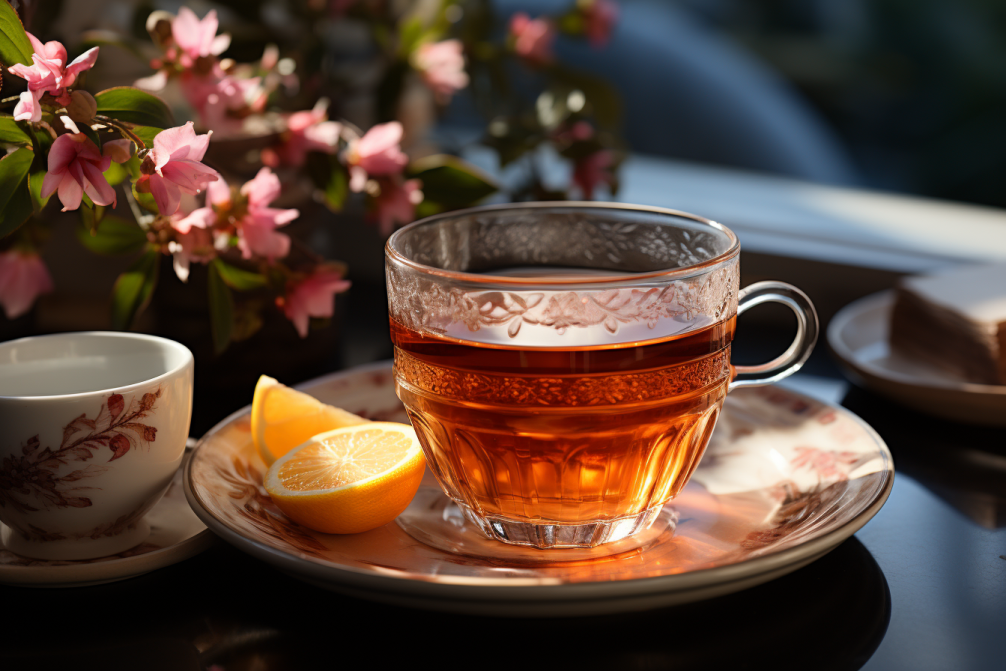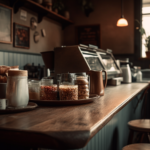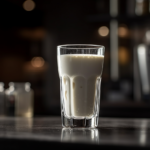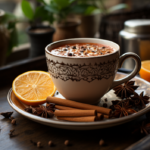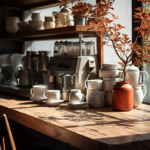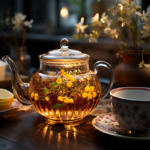Table of Contents
Choosing the Perfect Loose Leaf Tea: Your Guide to Home Brewing Excellence
Hey there, tea enthusiasts! If you’re like me and enjoy a warm and aromatic cup of tea to start your day or relax in the evenings, then you know that the quality of the tea leaves can make all the difference. Sure, tea bags are convenient, but nothing beats the flavorful experience of brewing with loose leaf tea.
Whether you’re a seasoned tea connoisseur or just starting out your tea journey, selecting the best loose leaf tea can be a daunting task. With so many varieties and flavors available, how do you choose the right one that suits your taste buds and brewing preferences? Well, fear not! In this ultimate guide, we’ll take you through the wonderful world of loose leaf tea and help you find the perfect brew for your home sipping pleasure.
We’ll be exploring the important factors to consider when selecting loose leaf tea, such as the type of tea, its origin, and the unique qualities that set each kind apart. We’ll also delve into the different flavor profiles, brewing methods, and even some helpful tips on how to store your tea to maintain its freshness and full-bodied taste.
So whether you’re a fan of classic black teas, refreshing green teas, fragrant herbal blends, or exquisite oolongs, get ready to embark on a tea-tasting adventure as we uncover the secrets to choosing the best loose leaf tea for your home brewing pleasure.
Tea Bags: Making the Right Choice
When it comes to choosing between loose leaf tea and tea bags for your home brewing, it’s important to understand the key differences and consider your preferences.
The Quality of Tea: Loose leaf tea tends to consist of whole leaves or larger broken leaves, allowing for better flavor extraction during brewing. In contrast, tea bags often contain smaller grade tea particles that might affect the taste and overall quality of the brew.
Flavorful Experience: Loose leaf tea offers a more aromatic and nuanced flavor profile compared to tea bags. The larger leaves provide a richer taste, while the ability to adjust the tea-to-water ratio allows for a more customized and satisfying cup of tea.
Customization: With loose leaf tea, you have more control over the strength and flavor of your brew. You can adjust the quantity of tea leaves and steeping time to achieve the desired taste, whereas tea bags come pre-measured and often lack flexibility.
Environmental Impact: Opting for loose leaf tea is a more sustainable choice. Tea bags are typically made from paper or plastic, adding to landfill waste. Loose leaf tea, on the other hand, can be brewed using reusable infusers or strainers, reducing the environmental impact.
Cost Considerations: Although loose leaf tea may seem pricier upfront, it offers better value in the long run. Loose leaf tea allows for multiple infusions from a single serving, making it more cost-effective compared to single-use tea bags.
Considering these factors, loose leaf tea provides a superior brewing experience, offering higher quality, customization options, and a more eco-friendly approach. So why not take the plunge into the world of loose leaf tea and savor the delightful flavors it has to offer?
No products found.
Exploring Different Types of Loose Leaf Tea: From Black to Green and Beyond
When it comes to choosing the best loose leaf tea for home brewing, understanding the different types available is key. Let’s dive into the world of loose leaf tea and explore the unique characteristics of each kind:
Black Tea: Known for its strong, bold, and robust flavors, black tea is a classic favorite for many tea enthusiasts. Its leaves are fully oxidized, resulting in a rich and distinct taste. Whether you prefer a hearty Assam, a malty English Breakfast, or the depth of a Darjeeling, there’s a black tea for every palate.
Green Tea: With its light, grassy, and refreshing taste, green tea offers a delightful brew that is packed with antioxidants. The leaves are minimally oxidized, retaining their natural green color and fresh aroma. From the popular Japanese matcha to the delicate Chinese Dragon Well, green tea provides a soothing and revitalizing cup.
Oolong Tea: Falling between green and black tea in terms of oxidation, oolong tea offers a diverse range of flavors. From the floral and fruity notes of a high mountain oolong to the roasted and nutty undertones of a darker variety, oolong tea provides a nuanced and complex drinking experience that is sure to impress.
White Tea: Known for its delicate, floral, and subtle notes, white tea is the least processed of all teas. Its leaves are picked during the early stages of growth, resulting in a brew that is light, refreshing, and gentle on the palate. White peony and silver needle are popular white tea varieties celebrated for their delicate flavors.
Herbal Tea: For those seeking a caffeine-free alternative, herbal tea is a fantastic option. Made from a variety of botanical ingredients such as herbs, spices, flowers, and fruits, herbal teas offer a wide range of flavors and health benefits. From soothing chamomile to invigorating peppermint, there’s an herbal tea blend suitable for any preference.
With these diverse types of loose leaf tea to choose from, you can now embark on a flavorful adventure and discover the perfect brews that align with your taste preferences. Happy brewing!
No products found.
Determining Your Flavor Profile: Finding the Taste That Tickles Your Taste Buds
When it comes to choosing loose leaf tea for home brewing, considering your flavor profile can greatly enhance your tea-drinking experience. Here are some popular flavor profiles to help you find the taste that tickles your taste buds:
Bold and Robust: If you enjoy a strong and robust cup of tea, go for teas like Assam black tea or Pu-erh tea. Assam black tea is known for its malty and full-bodied flavor, perfect for pairing with milk or enjoyed on its own. Pu-erh tea offers a unique earthy taste with deep complexities that develop over time.
Floral and Fragrant: For those who appreciate the delicate and aromatic qualities of tea, options like Jasmine green tea and Rose herbal tea are excellent choices. Jasmine green tea is renowned for its jasmine flower-scented leaves, providing a soothing and fragrant experience. Rose herbal tea offers a romantic and floral aroma with a subtle sweetness.
Earthy and Woody: If you prefer teas with an earthy and woody flavor profile, consider trying Tie Guan Yin oolong tea or Yerba Mate tea. Tie Guan Yin oolong tea has a distinct orchid aroma and a smooth, mellow taste. Yerba Mate, a traditional South American tea, offers a rich, smoky flavor with hints of grassiness.
Fruity and Sweet: For a tea-drinking experience bursting with fruity and sweet notes, opt for selections like berry-infused black tea or Hibiscus herbal tea. Berry-infused black tea combines the boldness of black tea with the natural sweetness of berries. Hibiscus herbal tea offers a vibrant, tangy taste with deep crimson color and a refreshing tartness.
Determining your flavor profile will help you select teas that best align with your taste preferences. Don’t be afraid to explore various flavors and experiment with blends to find your ultimate cup of tea. The beauty of loose leaf tea lies in its ability to provide a personalized and flavorful journey. Cheers to finding the taste that satisfies your cravings!
Considering the Origins: Discovering the Source of Your Tea Leaves
When it comes to choosing the best loose leaf tea for home brewing, considering the origins of your tea leaves can greatly impact the quality and flavor of your brew. Here are a few notable tea regions to explore:
Assam, India: Known for its sprawling tea gardens, Assam produces black teas with a strong and malty flavor profile. These teas are often a staple in breakfast blends and provide a robust and energizing cup.
Darjeeling, India: Nestled in the foothills of the Himalayas, Darjeeling is famous for its delicate and aromatic black teas, as well as its semi-oxidized oolong teas. These teas offer a refined and nuanced flavor experience with floral and muscatel notes.
Fujian, China: Fujian province in China is renowned for its production of white, green, and oolong teas. From the delicate and subtly sweet White Peony to the renowned Jasmine Dragon Pearls, Fujian offers a wide range of flavors that cater to different taste preferences.
Uji, Japan: Uji is a region synonymous with matcha and high-quality Japanese green teas. The tea leaves grown here are shade-grown, resulting in vibrant green colors and distinctive umami flavors. Uji matcha is specifically revered for its ceremonial-grade quality.
South Africa: For those seeking a caffeine-free alternative, the Western Cape province of South Africa is known for producing Rooibos. This herbal tea is naturally sweet, with a smooth and earthy flavor. Rooibos is enjoyed both hot and iced, making it a versatile and refreshing choice.
Understanding the origins of your tea allows you to appreciate the unique characteristics that each region brings to the cup. Take a journey through the tea gardens of Assam, the misty hills of Darjeeling, or the picturesque landscapes of Fujian and Uji. Exploring the origins of your tea leaves can provide a deeper connection to the tea-making process and add an extra layer of enjoyment to your home brewing experience.
Grading and Quality: Unraveling the Mystery of Tea Leaf Grades
When it comes to choosing the best loose leaf tea for home brewing, understanding tea leaf grades is essential in determining the quality and characteristics of the tea. Here’s a breakdown of the different grades you may encounter:
Understanding Tea Leaf Grades: Tea leaf grading is a system used to classify leaves based on their size, appearance, and quality. This classification helps discern the flavor, character, and brewing potential of the tea.
Whole Leaf Grades: Whole leaf grades are considered the highest quality and often boast the most impressive flavor profiles. These grades consist of whole, unbroken tea leaves and include designations like:
- SFTGFOP (Super Fine Tippy Golden Flowery Orange Pekoe): This is the top-quality grade, featuring young tea buds with golden tips.
- FTGFOP (Fine Tippy Golden Flowery Orange Pekoe): A high-quality grade known for its long and well-twisted leaves.
- OP (Orange Pekoe): A widely used grade, consisting of larger, coarse leaves.
Broken Leaf Grades: Broken leaf grades are lower on the scale but still offer good brewing potential and taste. These grades consist of broken or fragmented leaves and include designations such as:
- FOP (Flowery Orange Pekoe): A medium-grade with larger leaf pieces and a flowery appearance.
- BOP (Broken Orange Pekoe): Smaller leaf fragments that brew a bolder, stronger cup.
- GFBOP (Golden Flowery Broken Orange Pekoe): A higher-grade broken leaf tea with some golden tips.
Fannings and Dust Grades: Fannings and dust grades are considered lower quality due to their small particle size, yet they can provide a convenient and quick brewing experience. These grades are commonly used in tea bags and include:
- Fannings: Small, broken leaf particles often used for tea bags or quick infusions.
- Dust: The smallest tea particles used in tea bags for rapid brewing.
Understanding tea leaf grades allows you to explore different quality levels and select teas that match your preferences. Whole leaf grades offer heightened flavor complexity, broken leaf grades provide a balance between flavor and convenience, while fannings and dust grades deliver quick and consistent brews. So, let the knowledge of tea leaf grades guide you in unraveling the mystery and choosing the right loose leaf tea for your home brewing adventures!
Brewing Techniques: Choosing the Perfect Method for Your Loose Leaf Tea
When it comes to brewing loose leaf tea at home, there are several techniques to consider. Each method offers a unique way to extract the flavors and characteristics of the tea leaves. Here are some popular brewing techniques to help you choose the perfect method for your loose leaf tea:
Steeping: This classic and versatile brewing method involves steeping loose leaf tea in hot water for a specific amount of time. It allows for easy customization and works well with various types of tea. Simply add the desired amount of tea leaves to a teapot or infuser, pour hot water over them, and let steep. Adjust the steeping time based on the type of tea to achieve the desired strength and flavor.
Gaiwan: This traditional Chinese brewing vessel consists of a lidded bowl, ideal for delicate and high-quality teas. The gaiwan allows for multiple infusions and precise control over steeping time. It showcases the delicate aromas and flavors of teas like white tea, green tea, and oolong tea.
Gongfu Cha: Translating to “tea with skill,” Gongfu Cha is a Chinese tea ceremony that involves multiple short infusions to extract strong and intense flavors. It requires a gaiwan or a small teapot, allowing for precise control over the brewing process. Gongfu Cha is often used for oolong and pu-erh teas to highlight their complex profiles.
Kyusu: This traditional Japanese teapot is specifically designed for brewing green teas. Its built-in mesh filter ensures a smooth pour, capturing the leaves while allowing the tea to infuse properly. The Kyusu brewing method brings out the fresh and vibrant flavors of green teas like sencha and genmaicha.
Cold Brewing: If you prefer a refreshing and flavorful alternative, cold brewing is an excellent choice. It involves steeping tea leaves in cold water for an extended period to create a smooth and naturally sweet iced tea. Cold brewing works well with various tea types, including herbal teas, green teas, and fruity blends.
Each brewing technique offers its own unique experience, bringing out different elements of the tea’s flavor profile. Consider the type of tea you’re brewing and the desired strength and character you want to achieve. Whether you choose the classic steeping method, the delicate art of gongfu cha, or the convenience of cold brewing, finding the perfect brewing technique will elevate your tea enjoyment to new heights.
Storing Tea for Optimal Freshness: Preserving the Aroma and Taste
Proper storage is essential for preserving the freshness, aroma, and taste of your loose leaf tea. Here are some essential tips to ensure your tea stays in optimal condition:
Airtight Containers: Tea leaves are susceptible to air, light, moisture, and strong odors, as they can quickly degrade the quality. Store your loose leaf tea in airtight containers, such as tin cans or glass jars with tight-fitting lids. This will help protect the tea from external elements that can compromise its flavor.
Temperature: Tea leaves are best stored in a cool and dry place, away from direct sunlight and heat sources. Excessive heat can accelerate the aging process and alter the taste. Avoid storing tea near stoves, ovens, or other warm areas of your kitchen.
Avoid Refrigeration: While it may seem tempting, refrigeration is not ideal for storing tea. It can introduce moisture into the leaves, leading to a loss of flavor and quality. The fluctuating temperatures inside the refrigerator can also affect the tea’s aroma.
Separate Flavors: To prevent cross-contamination and preserve each tea’s unique flavors, store different types of tea in separate containers. Each tea has its own distinctive aroma, and storing them separately will allow each tea to maintain its original character.
Smell Test: Before brewing your tea, give it a quick sniff. If you detect any off odors, mustiness, or signs of spoilage, it’s best to discard the tea. Fresh tea leaves should have a pleasant aroma, indicating their quality and freshness.
By following these storage tips, you can ensure that your loose leaf tea remains fresh, flavorful, and aromatic for a longer period. Proper storage enhances the overall tea-drinking experience, allowing you to savor the true essence of the tea every time you brew a cup. Cheers to preserving the quality of your loose leaf tea!
Making Informed Purchases: Where to Buy the Best Loose Leaf Tea
When it comes to buying the best loose leaf tea for home brewing, there are various avenues to explore. Here are some places to consider when making informed tea purchases:
Specialty Tea Shops: Specialty tea shops are dedicated establishments that focus on offering a wide selection of high-quality loose leaf teas. These shops often have knowledgeable staff who can guide you through the different tea options and provide recommendations based on your preferences. You can explore a range of flavors, origins, and tea blends, ensuring a unique and personalized tea-buying experience.
Online Retailers: Online platforms have made it incredibly convenient to purchase loose leaf tea from the comfort of your home. Numerous online retailers specialize in tea, providing a vast selection of options, including specialty teas from different regions. Look for reputable sellers with positive customer reviews and consider their sourcing and quality standards before making a purchase.
Farmer’s Markets: Local farmer’s markets are excellent places to discover unique blends and interact directly with tea producers. Here, you can find teas that are sourced locally or from nearby regions. Engaging with tea growers and makers allows you to learn about their farming practices, giving you a deeper understanding of the tea’s origin and quality.
Tea Subscription Services: Tea subscription services offer a convenient way to explore a variety of loose leaf teas. These curated boxes often include a selection of different teas delivered to your doorstep on a regular basis. Subscribing to such services can introduce you to new flavors, tea styles, and regions, making your tea journey even more exciting.
Recommendations and Reviews: Seek recommendations and reviews from fellow tea enthusiasts or trusted sources. Online forums, social media groups, and reputable tea blogs can provide valuable insights and suggestions regarding the best places to buy loose leaf tea. Hearing about others’ experiences can guide you in finding reputable sellers and specific teas that align with your preferences.
By exploring these avenues, you can make informed purchases and find the best loose leaf tea for your home brewing adventures. Whether you choose to browse specialty tea shops, explore online platforms, or connect with local tea producers, the world of loose leaf tea is waiting to be discovered. Happy tea hunting!
Experimenting with Blends: Unleashing Your Creativity with Tea Mixology
One of the joys of brewing loose leaf tea at home is the opportunity to unleash your creativity through tea mixology. By experimenting with blends, you can create unique flavor combinations that tantalize your taste buds. Here are some tips to get started:
Understanding Flavor Profiles: Get to know the flavor profiles of different teas and ingredients. The key is to find flavors that complement and contrast with one another. This knowledge will help you create harmonious and exciting blends.
Single Tea Combos: Start by combining different varieties of the same type of tea. For example, mixing different black teas can add complexity to your brew. Blend Assam with Darjeeling for a rich and floral cup, or combine Ceylon and Keemun for a smooth and bold flavor.
Herbal and Fruit Infusions: Dried fruits, herbs, and spices are fantastic additions to your tea blends. Enhance the taste by adding dried orange peel to black tea or infusing chamomile with dried lavender for a calming floral blend. Get creative with spices like cinnamon, cardamom, or ginger for added depth.
Floral and Herbal Pairings: Explore the world of floral teas and pair them with complementary herbs. Combine delicate rose petals with fragrant jasmine green tea or mix hibiscus petals with refreshing peppermint for a unique and invigorating blend.
Sweet and Savory Twists: Don’t be afraid to think outside the box and add unexpected flavors. Infuse a black tea with a sprinkle of cocoa nibs or mix a green tea with a hint of lemongrass and thyme. These surprising combinations can lead to delightful discoveries.
Remember, tea mixology is all about experimentation and having fun. Start with small quantities and adjust the ratios to suit your taste. Build on your successes, and don’t be discouraged if some blends don’t work out. Let your imagination run wild, and enjoy the journey of creating your signature tea blends that reflect your unique taste preferences. Cheers to the exciting world of tea mixology!
Embracing Tea Culture: Exploring Tea Rituals and Traditions from Around the World
Tea is not just a beverage; it’s a rich tapestry of rituals and traditions woven across different cultures. Embracing tea culture allows us to deepen our appreciation for this beloved drink. Here are some tea rituals and traditions from around the world to explore:
Japanese Tea Ceremony: The Japanese Tea Ceremony, also known as Chanoyu, embraces tranquility and mindfulness. It involves a series of elegant and carefully choreographed movements, from the preparation of matcha tea to its ceremonial serving. This ritual promotes a sense of calmness and unity with nature.
Chinese Gongfu Cha: Gongfu Cha is a Chinese tea ceremony that celebrates tea through precise pouring, steeping, and enjoying. It honors the art of tea-making, allowing for multiple infusions to bring out the flavors and aromas of oolong and pu-erh teas. Gongfu Cha emphasizes the artistry and craftsmanship of tea brewing.
Moroccan Mint Tea: In Morocco, tea is more than just a beverage; it’s a symbol of hospitality and warmth. The Moroccan Mint Tea, also known as Maghrebi tea, involves the pouring of mint-infused green tea from a height, creating a foamy and aromatic blend. It is often a part of social gatherings and signifies generosity and friendship.
British Afternoon Tea: British Afternoon Tea is a delightful indulgence that includes a variety of teas, accompanied by scones, finger sandwiches, and pastries. This tradition, which dates back to the 19th century, showcases class and elegance. Afternoon Tea is a charming way to relax and enjoy the company of friends while savoring an array of teas and treats.
Indian Chai: In India, chai holds a special place in the heart of its people. A blend of strong black tea, aromatic spices, milk, and sugar, Indian Chai is a flavorful and invigorating beverage. It is a common sight to see chai vendors on every street corner, brewing this beloved drink and infusing the air with its enticing aroma. Chai is an integral part of social gatherings and signifies warmth and togetherness.
Exploring tea rituals and traditions allows us to connect with different cultures and experience the beauty and depth of tea beyond its taste. Whether it’s the Zen-like serenity of a Japanese Tea Ceremony, the artistry of Chinese Gongfu Cha, the hospitality of Moroccan Mint Tea, the elegance of British Afternoon Tea, or the invigorating flavors of Indian Chai, each tea ritual offers a unique glimpse into the customs and traditions that have evolved around this beloved beverage. So, brew a cup of tea, immerse yourself in the richness of tea culture, and appreciate the traditions that have stood the test of time.
Conclusion
In conclusion, choosing the best loose leaf tea for home brewing is an exciting journey that involves exploring different types, flavors, and brewing techniques. By understanding the various types of loose leaf tea, such as black, green, white, oolong, and herbal varieties, you can find the perfect cups that match your taste preferences. Considering factors like tea leaf grades, origins, and flavor profiles further enhance your tea-drinking experience.
Experimenting with tea blends and engaging in tea rituals from around the world adds an extra layer of creativity and cultural appreciation to your brewing routine. Whether it’s the tranquility of a Japanese Tea Ceremony, the precise artistry of Chinese Gongfu Cha, the warmth of Moroccan Mint Tea, the elegance of British Afternoon Tea, or the vibrant flavors of Indian Chai, tea offers a rich tapestry of rituals and traditions to embrace.
Proper storage techniques ensure the freshness of your loose leaf tea, while exploring different places to buy, like specialty tea shops, online retailers, or local farmer’s markets, allows you to access a wide range of high-quality teas. With the versatility and endless possibilities of loose leaf tea, you can create your own signature brews and indulge in a world of flavors.
So, let loose leaf tea be your passport to an aromatic and flavorful adventure. Whether you’re a tea connoisseur or a newbie, there’s a perfect tea waiting to be brewed and savored in the comfort of your own home. Cheers to finding your ultimate cup of tea and enjoying every sip along the way!

